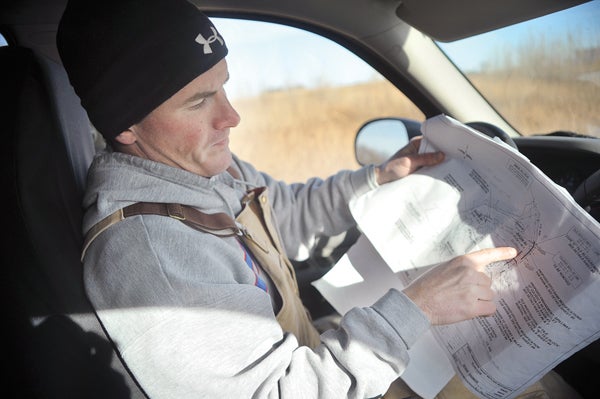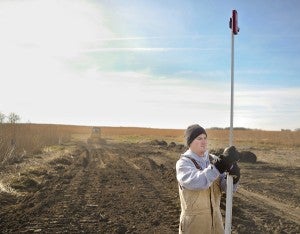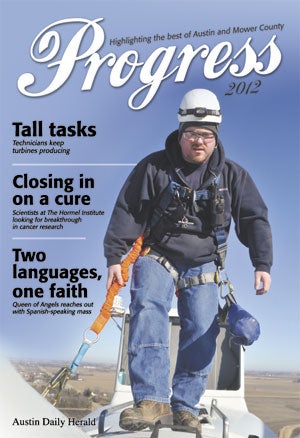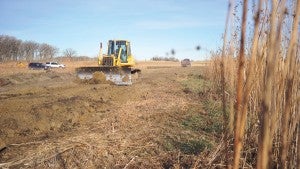Conserving Mower County
Published 1:12 pm Thursday, March 8, 2012

Mower County Soil and Water Conservation District Resource Specialist Justin Hanson looks over a topographical map of land northwest of Austin this past fall. The land was part of a wetland restoration project where tile is ripped up from fields to slow water flow. — Eric Johnson/photodesk@austindailyherald.com
Justin Hanson works full-time to protect the area’s natural resources
This story originally appeared in Progress 2012, which published Sunday, Feb. 26.
One could say Justin Hanson has a full-time job in persistence. Without that trait, he would likely be doing something else.

Mower County Soil and Water Conservation District Resource Specialist Justin Hanson takes an elevation reading on a plot of land northwest of Austin that's being restored to wetland.
As a man who persuades farmers to retire farmland for conservation projects, he’s no stranger to the word “no.”
“We spend a lot of time failing,” Hanson said about his job. “It’s like baseball — you miss more than you hit.”
So he keeps swinging.
Hanson is a resource specialist with the Mower Soil and Water Conservation District, and though he’s all about preserving the land and protecting the water, he knows he wouldn’t have a job without farmers. His job relies on their land, which is also why his job may become increasingly difficult.
Even when farmers show interest in collecting government money for retiring their farmland, they rarely pull the plug on their crops.
“We took 15 sign-ups last year for this flood recovery program and then got one of them,” Hanson said. “You kind of bang your head against the wall.”
The best way Mower SWCD can preserve land and protect water, however, is by enrolling farmers’ lands into permanent easements. Those projects take a long time to start, sitting down at kitchen tables and getting to know farmers, often with no success. But that’s Hanson’s job.
“He has tremendous people skills, so he’s able to work with landowners very well,” said Bev Nordby, Mower SWCD district manager. “He’s definitely an asset to our office.”
Nordby knows Hanson’s success rate is more like a batting average. That’s why his body of work can still be considered successful.
Since Hanson came to the district in 2004, he has put nearly 30 pieces of property into easements. Now Mower SWCD is tracking the results those projects have on water quality. Hanson hopes to see Mower County’s high turbidity, or amount of sediment in water, fall back within state standards.
“We’ve put a lot of time into studying turbidity,” Hanson said. “Getting down to the state standard in turbidity is a big deal. If we can get there in my lifetime, that would be outstanding.”
Hanson considered 2011 a productive year. He convinced three landowners to put plots into wetland restorations, along with one who enrolled in an aquatic restoration. Hanson carefully surveyed elevations while crews pulled tile lines from the ground, made earthen embankments to reduce water flow and planted native grasses to trap sediment.
Digging for state and federal dollars to dole to farmers, coupling existing conservation programs and finding new ways to promote conservation are all ways Hanson tries to stay ahead of the game, especially with farmland being so valuable.
“In the meantime, you get creative,” Hanson said about waiting for conservation programs to become more valuable. “It’s not like you put your hands in your pockets.”
Yet farming is very important in Mower County. Hanson understands the economics between conservation and farming, and he’s OK with it.
“We’ve seen the pendulum swing completely back the other way,” Hanson said about farming versus conservation. “It’s economical for people to farm as much as they can.”
Hanson knows there can be too much of a good thing, too, which is why his job is a constant balancing act. He recalls an example when conservation went too far. Many North Dakota farmers near one town put their lands into the Conservation Reserve Program when the program was favorable. That backfired.
“There was nothing left,” Hanson said about that area’s farm economy. “It killed the town, and now it’s a ghost town.”
Still, Hanson will always push for conservation. He grew up an outdoorsman, Boy Scout, went to college for conservation, and several of his friends are conservationists, as well. With such a strong farming community in Mower County and within the Cedar River watershed, Hanson’s job is important. That’s why Bev Nordby hired him nearly eight years ago.
“He worked in Jackson County SWCD, so he came with some experience,” Nordby said. “And we were trying to find someone that could hit the ground running.”
Because of the inherent failure rate as a resource specialist, Hanson may the best person for the job — because of his persistence.
“Your job here is really what you make of it,” Hanson said.







